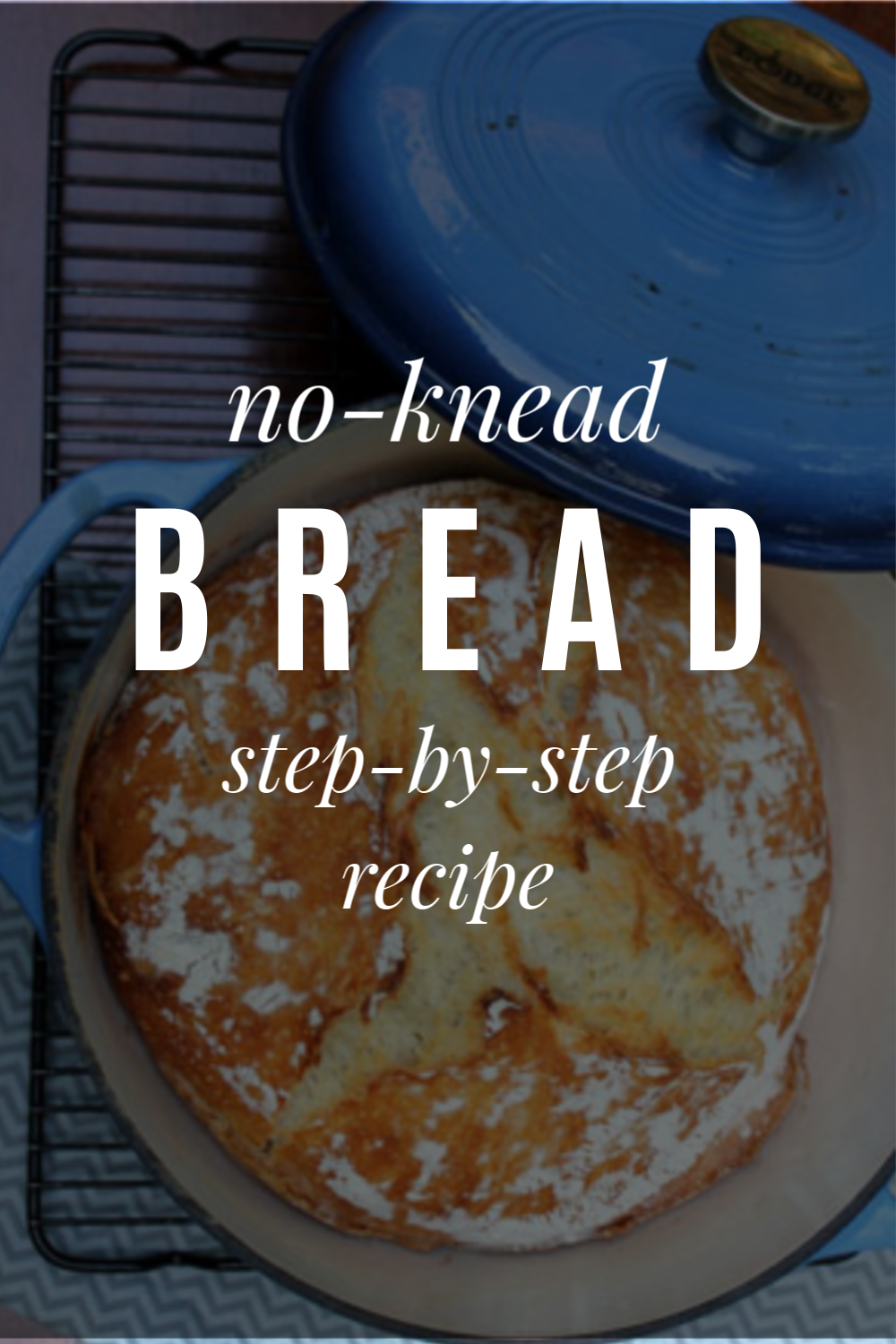
No-Knead Bread Recipe
If you have been hanging out around Frugal Living NW for awhile, you know that I am a big believer in making food from scratch at home. With a few exceptions, I prefer creating something in my own kitchen to buying it in the grocery store.
Bread can be tricky, though. There is some stiff competition out there, and it is tough to replicate a commercial oven’s heat and steam in a normal home kitchen.
For the last several years, I thought that Artisan Bread in 5 Minutes was the best thing since, well, sliced bread. It was simple, and we were content with the results. That is, until last summer when our neighbor brought over a beautiful, delicious loaf of home-baked bread. We had to know her secret. One phone call, and she came back with the book, My Bread by Jim Lahey (Amazon).
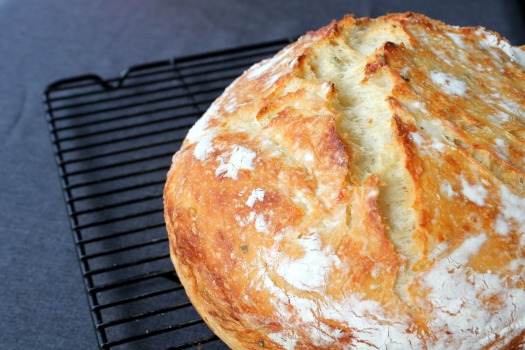
We have been baking bread using this method ever since. I can count on one hand the number of times I have bought bread in the store since then, because I can now make an artisan-quality loaf at home for a fraction of the cost.
I am telling you, this is consistently the best bread I have ever made in my kitchen. Okay, enough gushing. Let’s make some bread.
The only changes I have made to Lahey’s method is to double the amounts and adjust the baking time and temperature to achieve a bigger loaf with a thinner crust.
Oh, and don’t be put off by all these steps. This is totally possible for home bakers at any skill level. I wanted to give you the confidence to do this on your own. A concise recipe can be found at the bottom of this post.
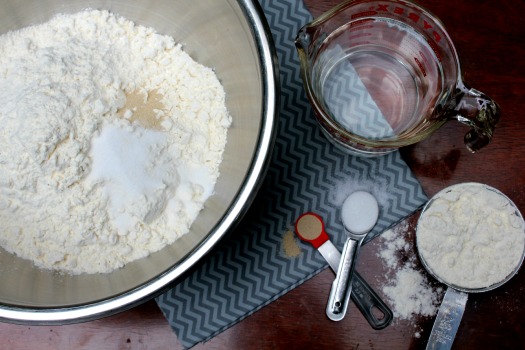
The ingredients are simple: flour, water, salt, and yeast. My husband calculated this bread costs 74¢ per loaf (using Bob’s Red Mill flour & Costco yeast).
Oh, wait! Don’t forget to factor in the roughly 8 cents of energy used to bake it for an hour. No, I’m serious. My husband really does think about this stuff! He’s funny.
So, there you go. A whopping 81¢ for a substantial 2.5 pound loaf of bread. That is crazy cheap.
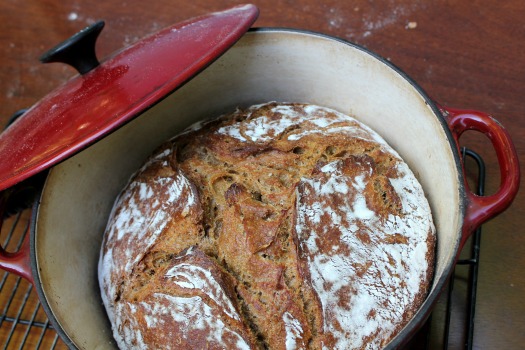
If you want to use some whole wheat flour, substitute 3 cups of whole wheat for 3 cups of the all-purpose flour (3 cups whole wheat and 3 cups of unbleached flour for a total of 6 cups) and add 3 Tablespoons of molasses (optional). This will produce a slightly sweeter, denser loaf of bread. Delicious.
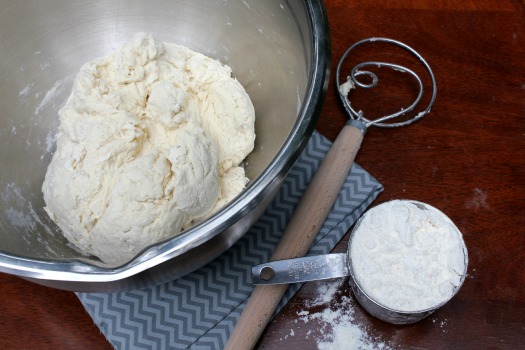
Combine the dry ingredients, add the water, and stir to combine (the funky looking wood-handled item is the amazing Danish Dough Wisk — makes stirring stiff dough a snap). The dough should be wet and sticky. Depending on the temperature and humidity in your home, you may need to add a little more flour or water, 1 Tablespoon at a time. So far, these steps are exactly the same as the 5 Minute method.
The main differences are that you use significantly less yeast (1/2 teaspoon vs. 1 1/2 Tablespoons) and significantly more initial rise time (12-18 hours vs. 2 hours).
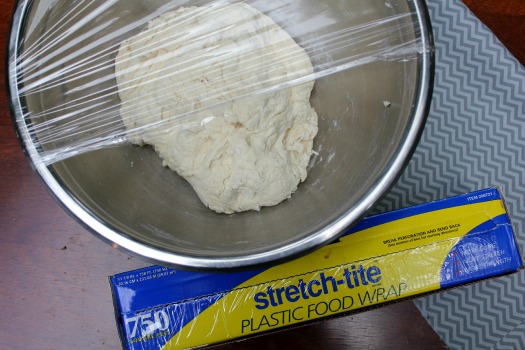
Once the ingredients are completely combined, cover the bowl with plastic wrap and leave it on the counter to rise for 12-18 hours. This slow rise aids in the fermentation of the yeast, giving the bread a better flavor.
Okay, I know what some of you are thinking: 12-18 hours! That’s ridiculous! Who has that kind of time?! I get it.
However, here are two things to consider:
- Once you get into a rhythm of baking your own bread, it’s not a big deal. I start mine in the afternoon or evening and bake it the next morning or afternoon. This would also be an easy weekend routine.
- Just like the title claims, this bread requires no kneading. It is not fussy, temperamental dough. You can produce a delicious loaf of bread with very little hands-on effort & experience.
You’ll know your dough is ready when it has risen in the bowl, smells yeasty, darkened slightly, and is covered with small bubbles.
Using well floured hands, shape and tuck the sticky dough into a rough ball. You can also fold it over a couple times on a well-floured surface. It doesn’t have to be perfect; just keep quickly tucking the dough underneath with your fingertips until you have a semi-smooth dough ball. The dough should be wet but manageable; you don’t want a wet blob so sticky that you can’t shape it into a ball.
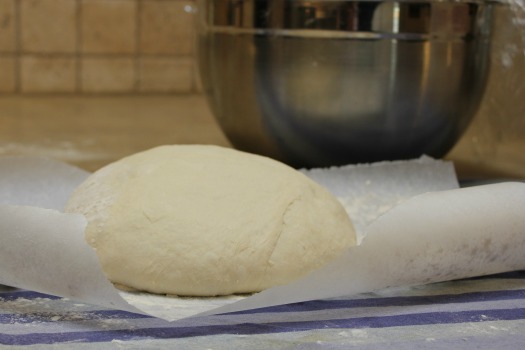
Take a clean linen or cotton tea towel (not terry cloth) and dust it with flour, cornmeal, or wheat germ to prevent the dough from sticking to the towel as it rises. You can also use a floured square of parchment paper on the towel to make the dough ball easier to handle. Place the dough ball, seam side down, in the middle and dust with more flour.
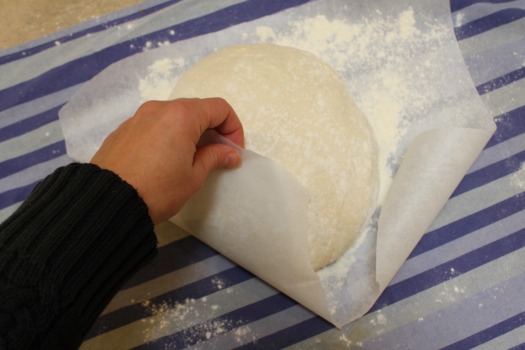
Cover the dough with the (parchment paper and) towel and let it rise for 1-2 hours at room temperature, until doubled in size. During the last 30 minutes of rise time, place a heavy lidded 6-8 quart pot, like a Dutch oven, in a cold oven and preheat it to 425 degrees.
Confession: I own three Dutch Ovens. I use them all the time. They are incredibly versatile and worth the investment. If you don’t own one, you could also make this in any lidded pot, provided it is oven-safe at such high temperatures. Also, check the knob on your pot. If it isn’t rated for such high heat, you’ll want to remove it or cover it with foil. You can also buy an inexpensive replacement knob that is rated for higher temps!
Okay, this is the trickiest part of the entire operation. Remove the lid from the piping hot Dutch Oven, slide your hand underneath the towel or parchment paper, and flip the risen dough (seam side up now) into the pot. Try to flip close to the pot or the flour will fly everywhere. Remove the towel or paper and set aside.
This might take a bit of practice, but again it doesn’t have to be perfect. Some of my worst flips have produced my most beautiful loaves. I love what Lahey writes, “…even the loaves that aren’t what you’d regard as perfect are way better than fine.”
Place the lid back on top and slide the pot back into the hot oven.
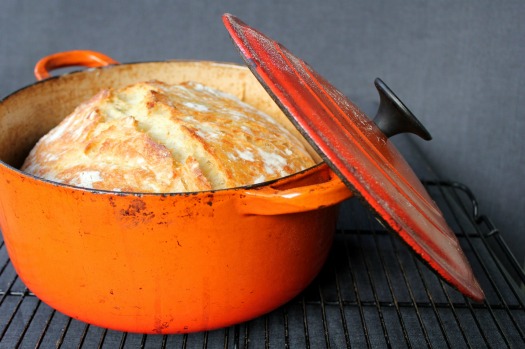
Bake it for 40-50 minutes. Remove the lid. Bake for another 5-10 minutes, until golden chestnut brown. The internal temperature should be around 200 degrees. You can check this with a meat thermometer if you’re nervous about knowing when your loaf is done.
Oh man, your house will smell so good about right now.
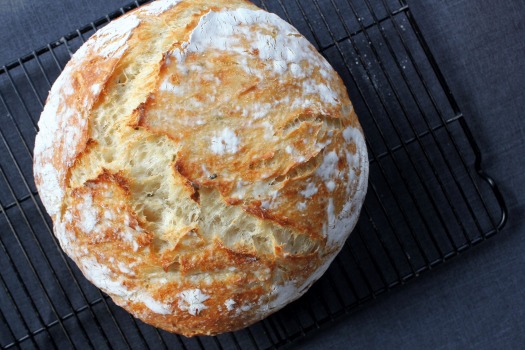
Place the loaf on a cooling rack. You will hear it crackling as it cools. Use every ounce of self-control to resist cutting into it until it is “quiet”; cutting it too soon will make the bread dense and gummy.
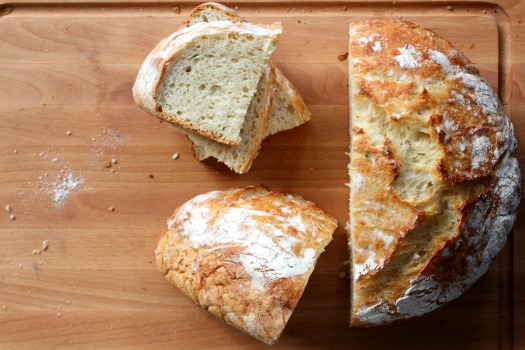
This bread is best the first 2-3 days. I just store my leftover loaf inside the Dutch oven on the countertop. Using plastic wrap will soften the crust. Dry, leftover bread makes great bread crumbs, toast, French toast, or croutons!
Enjoy. And pat yourself on the back. You just baked an amazing loaf of bread!
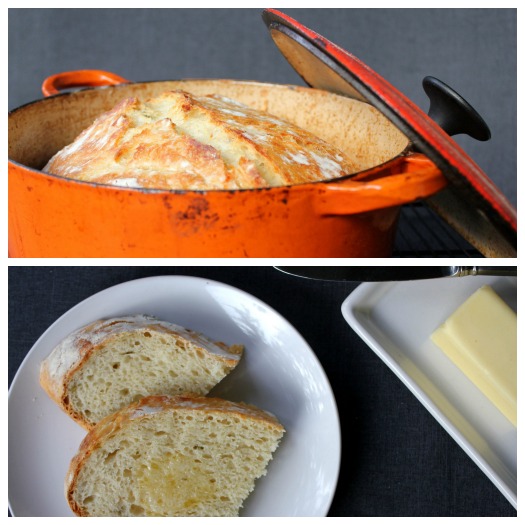
Basic No-Knead Bread
Slightly adapted from Jim Lahey’s My Bread
Ingredients
6 cups bread flour (recommended) or all-purpose flour, plus more for work surface
1/2 t. instant or active-dry yeast
2 1/2 t. salt
2 2/3 c. cool water
- In a large bowl, combine the flour, yeast, and salt. Add the water and stir until all the ingredients are well incorporated; the dough should be wet and sticky. Cover the bowl with plastic wrap. Let the dough rest 12-18 hours on the counter at room temperature. When surface of the risen dough has darkened slightly, smells yeasty, and is dotted with bubbles, it is ready.
- Lightly flour your hands and a work surface. Place dough on work surface and sprinkle with more flour. Fold the dough over on itself once or twice and, using floured fingers, tuck the dough underneath to form a rough ball.
- Place a full sheet/large rectangle of parchment paper on a cotton towel and dust it with enough flour, cornmeal, or wheat bran to prevent the dough from sticking to the parchment paper as it rises; place dough seam side down on the parchment paper and dust with more flour, cornmeal, or wheat bran. Pull the corners of parchment paper around the loaf, wrapping it completely. Do the same with the towel. Let rise for about 2 hours, until it has doubled in size.
- After about 1 1/2 hours, preheat oven to 425 degrees. Place a 6-8 quart heavy covered pot, such as a cast-iron Dutch oven, in the oven as it heats. When the dough has fully risen, carefully remove pot from oven. Unwrap the towel and parchment paper from around the dough and slide your hand under the bottom of the dough ball; flip the dough over into pot, seam side up. Pull the parchment paper off, scraping any stuck dough into the pan. Shake pan once or twice if dough looks unevenly distributed; it will straighten out as it bakes.
- Cover and bake for 40 minutes. Uncover and continue baking for 10-15 more minutes, until the crust is a deep chestnut brown. The internal temperature of the bread should be around 200 degrees. You can check this with a meat thermometer, if desired.
- Remove the bread from the pot and let it cool completely on a wire rack before slicing.
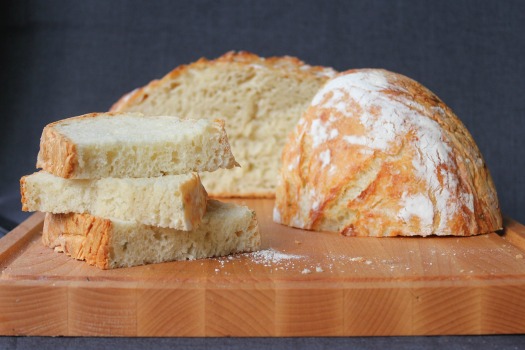
Here are a couple options for Dutch Ovens. Any heavy, lidded 5-8 quart pot (seasoned cast iron or enamel coated) would work with this recipe. Lodge has the best prices/options for dutch ovens on Amazon.
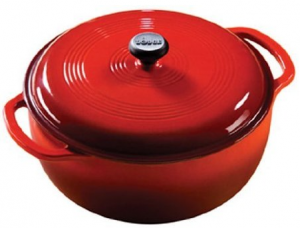
Lodge Logic Dutch Oven in Island Spice Red (6 Quart)
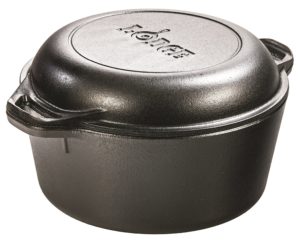
Lodge Cast Iron Double Dutch Oven (5 Quart)
If you already have a dutch oven (or find a deal on a lesser-known brand) that doesn’t have a knob rated for high temps, replace it! There are some really affordable options.
Got questions? You are in good company. Go here for the complete FAQ list.
Looking for more variations to the no-knead bread recipe? We’ve created a list with sweet and savory varieties, including the following:
- Cranberry Orange
- Four Cheese
- Sandwich Bread
- Dark Chocolate Coconut
- Tomato Basil Cheese
- Whole Wheat
Looking for more delicious bread recipes?
Find more delicious recipes on our Recipe Page!
Follow Frugal Living NW on Pinterest!
Fantastic range of boards from best recipes and tips for frugal living to gardening and budgeting help.
This post may contain affiliate links. See the disclosure policy for more information.
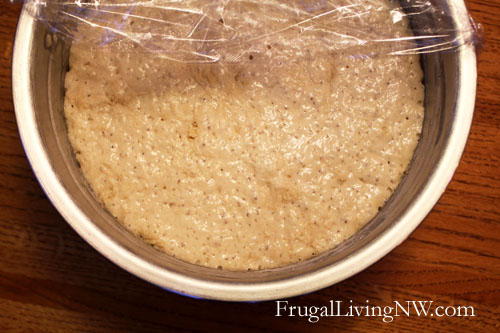
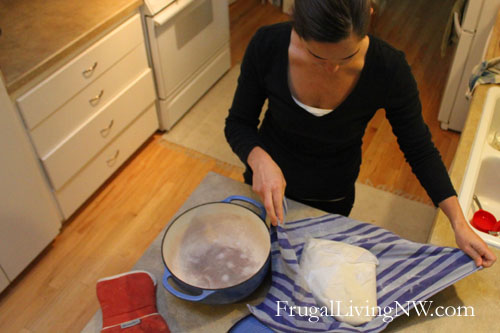
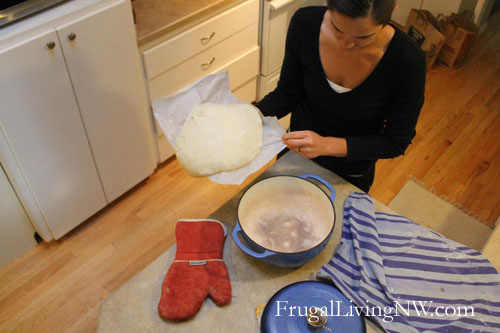

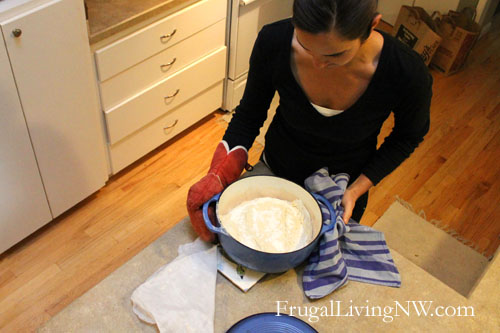


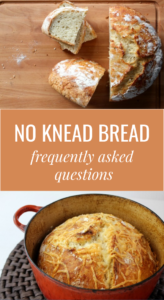
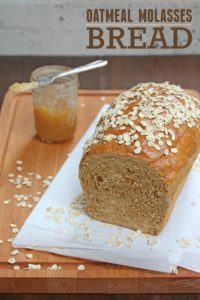
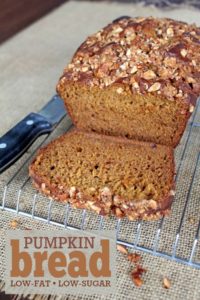
4ehy74
First attempt turned out amazing! Springy, just enough air, crusty, and so so so good. This is definitely going to become a staple. Thank you for such good instructions!
Has anyone figured out the calories and carbs by ounce?
Could you use this recipe with starter instead on yeast?
I’ve been using this recipe since I happened upon it in 2012 and feel like my kitchen skills have been elevated ever since. Easy and predictable results and people are always blown away by the end result. Tonight’s dinner is a lentil soup with fresh baked bread.
This bread is totally awesome! I will definitely make again!
Love this recipe! Like the slow rise. I didn’t have bread flour but used Bobs Red Mill AP. Turned out beautiful. Got another one in the making now.
Hello! I am so glad to find your site! My husband makes no-knead bread weekly and we love it. Lately, though, the loaves will have a fold of uncooked flour inside — sometimes near the crust and sometimes deeper within. What is a possible reason and solution? Thanks!
If you give no-knead bread dough a nice long proofing (say 16-24 hours) you can substitute a half cup of the flour with 9- or 12-grain cracked cereal, rolled oats/barley/rye, and other whole grains. The long proofing time gives ample opportunity for these whole grains to absorb moisture, then the contained baking/steaming cooks them beautifully.
I also make this bread with rye flour, molasses, and caraway. Substitute the molasses for the same amount of the water (i.e., reduce the water by that much).
Using whey from cheesemaking to replace part or all of the water helps supply that nice lactic acid tang with a long proofing.
Anyone reading this recipe who doesn’t have/can’t afford an enameled cast iron pan, in the interest of frugality, I bake these loaves on my Goodwill pizza stone with a roasting tray under it. Preheat to 450, slide bread in on stone or parchment on stone, and put 16 oz water in the (hot!) roasting tray. Great results every time. I kick the temp down to 350 20-25 minutes in, depending on loaf size, or when the interior bread temp is 160, then finish it at that temp (till 195 inside the loaf, which rises on its own to 200 when taken out of the oven). Just a small energy savings, but I bake three times a week.
There’s a guy on YouTube who gets incredible results baking this bread in a “poor man’s Dutch oven” consisting of two bread pans, one inverted over the other and held together with bulldog clips.
Absolutely love this easy recipe! I’ve made it so many times in the past year to keep from having to go to the store to buy bread and have loved my loaves!
A few tips from a very amateur home chef that I’ve found help me get softer bread (outside is still crusty but won’t give you a good snap if that’s what you’re looking for!):
– I use the sandwich bread variation from frugal living nw
– I normally start with two cups of water and then add as needed to get the perfect consistency. Depending on the weather and how humid my home is at that time of year, I might not need as much or need more than the 2 2/3 to get the perfect dough. Bottled or filtered water also seems to work best as water in my area is sort of hard.
– adding a small handful of shredded cheese helps to provide the much needed moisture my loaves were looking for to keep the inside soft and barely alters the flavor. I’ve used mild cheddar (no distinguishable taste for me) and also leftover cheeses from making Mac & cheese in another loaf so probably Gouda, Harvati or white cheddar (been a while since I used these so I can’t recall which exactly were used) and they all resulted in a perfect soft loaf.
Can you add more water if the dough is too dry?
It is easier to leave dough on the parchment and lift whole thing into pot. The parchment also helps lift the bread out when it’s done but is there a reason to place dough in the pot seam side up?
I made this bread yesterday and today and you’re right, the house smells amazing and it’s killing me not to cut into right now. LOL I halved the recipe because I didn’t have enough bread flour so my loaf is a bit flatter because it spread out more in the dutch oven but it looks amazing. It was super easy to make as well, I’ll definitely be making this again! Thanks for sharing the recipe!
Why do you flip the bread seam side up when baking the bread?
I have tried this recipe a number of times.
Getting the dough off the baking paper/ tea towel after the second rise had been a real pain, no matter how much it is floured.
The paper tends to tear into strips.
Why couldn’t the second rise be done in a floured bowl?
Would be much easier to get out.
Can’t see any reason why this would impede the process ‘chemically‘ from a yeast/gluten reaction point of view.
Yes, I do this – in a heavily floured bowl, and then just kind of roll the dough into the hot pot. Another option is to just lift the parchment with the dough and put it all into the pot like that, no flipping. It comes right off once baked.
I do not remove the risen dough from the parchment. Just pick up the four corners and plop into the dutch oven. Removing the paper after baking is not an issue.
I do the second rise right in the pot. I spray the parchment paper with a little oil, plop the dough into the middle of the pot. Let it rise for 2 hours, score the top, put the lid on & put the pot right into a cold oven. Turn the oven on & bake at 425 for 40 min, remove lid & bake for another 25 to 30 min. Testing bread for doneness after 20 min. Turns out great every time.
Excellent recipe!
I only have a 4.6L Dutch oven I’m wondering if this will work?
I make this every fortnight or so – my husband loves bread and I love how easy this is. I agree that the dough is a little dry, but I’ve always done it as written and it’s been fine (as a caveat, I know very little about baking).
I made this and it was worth the time! I posted it in one of the foodies Facebook Groups I belong to (we have 61,000+ members) and had several requests for the recipe. So, I’m sharing the link with them.
Hi, thank you for such a well written recipe! I wanted to tell you I do almost an identical recipe but there is a far easier way to transport the bread dough to the hot Dutch oven, just leave it on the parchment paper and lift the whole works into the oven. I start this process by putting a piece of crumpled up parchment paper (Crumpling and then flattening it makes it easier to make the parchment paper bend to the round shape) in a frying pan or a large bowl before I put the bread dough in it for its final rise, and when it’s ready to go into the Dutch oven, lift the whole works into the Dutch oven and bake per the recipe. The parchment paper can take the heat, and there’s less chance of burning your arms on the edge of the hot Dutch oven. Just make sure the parchment paper is big enough that there will be good edges to be able to grab onto.
Did this a couple of times came out great now the last two times had a few hard nots in dough don’t now why
I just made this for the first time and it is amazing!!! I followed the recipe exactly and let it sit the full 18 hours. I was a little worried from reading some comments about humidity (can’t get much more humid than where I am in Florida!). My dough was a little wet and sticky but I went ahead with instructions. Came out perfect! Will definitely make this simple recipe again!
I just made this bread and my dough was NOT wet at all – in fact all the flour was not dampened at all. I did add another cup of water. It is sitting now for the 18 plus hours.
Could you please verify the ingredients?
I don’t think your measure of water is correct. My dough was not wet at all so I added another cup of water equaling 3. 2/3 cup.
Can you verify the measurements ?
I too had to add more water. Not sure why? I just added about 1/3 cup but could have added more I think…we’ll see.
Baked this bread today – thank you for sharing the recipe! It looked just like your pictures and my family and I enjoyed it with salted butter and strawberry jam. Now all we need is a better bread knife to cut such a big loaf. I’m sure we’ll eat it all in a few days, tops. Love that it’s four ingredients and that I was able to mix and then forget about it for 18 hours! Gotta love kitchen science. Thanks, again.
I’m sure we’ll eat it all in a few days, tops. Love that it’s four ingredients and that I was able to mix and then forget about it for 18 hours! Gotta love kitchen science. Thanks, again.
This is the third or fourth time I’ve made this bread and my family just loves it! It’s so simple and delicious, I share it with everyone that asks how I made it.
I can’t believe I made something so pretty and yummy! I did ‘mix’ it by hand and I cut the salt down to 1/2 tsp for high BP reasons and it turned out beautifully!!!
Thank you!!!
I love this loaf and marvel how well it rises with so little yeast! Love it. Do you have any tips and tricks for cutting uniform and thin slices for sandwiches? I make mine in a4 qt Dutch oven so it’s bigger than all of the bread slicer contraptions that I’ve seen. Thanks
So I followed the recipe to the T and my dough is a wet sticky mess. I used the only flour I have which is a light self rising flour? Could that be the problem? Old yeast ? I’m confused but will try again. I ordered a bread flour on line to see if that helps.
Sometimes it just is sticky. It might have to do with the humidity in your area? Just add a bit more flour and make sure you heavily flour your surface and hands when handling the dough. It should still make delicious bread!
I make this bread, if you wet your hands you can handle the bread much easier. Yes, it is sticky, but it is better to mold with wet hands. I also put mine on parchment paper and lift it with the paper and set it it in the pan, the paper will get brown, but won’t burn, also my way of lifting it out.
This has been my go to recipe for about 2 years. I have tried other recipes that look the same but this one is the best. I do reduce the temp to 400 but that might be due to my old oven. Thank you so much for the recipe! I love the sound of the bread crackling right after it come out of the oven. I feel like remi from ratatouille.
Great bread. Bought 7qt. Dutch oven and the loaf is huge. Anyone try this in baking in regular pans to make smaller loaves.
OMG this recipe is amazing! It was wonderful the first night and we had it toasted tonight, delicious! I am going to make it again to make sure I can duplicate the results then it will be my go to recipe! Love it!
Can this recipe be used for pizza?
Do I need to proof the active dry yeast in a separate bowl first?
You shouldn’t have to! We’ve made it multiple times without proofing the yeast.
Hi Angela! New to your site, and excited I found you! Hope you’re staying well!
Hope you’re staying well!
I just ordered a pot from Sur la Table and it happens to be a 4 qt Staub (because it was on a great sale!!) so I’m wondering if this bread would work in a pot that size? I also have a huge 7 1/2 qt le creuset but i’m hoping the 4 qt could work with your exact measurements! (I bought it specifically to make bread!) Thanks for any thoughts on this size pot!
If you want to use your 4 quart pot, just half the ingredients. It will work just like the full recipe.
I love this bread. Even with my mistakes it turns out perfect. I do have one question. Why do we need to turn bread into Dutch oven seam side up? It’s easier to lift the dough on the parchment and it provides a way of lifting it out.
And why not just flour the towel and lay on top of the dough for rising instead of u dear eats. Don’t get why?
Just a few curiosities but if there’s some reason it makes it better I’d like to know. Thank you so
Much for this wonderful adaptation